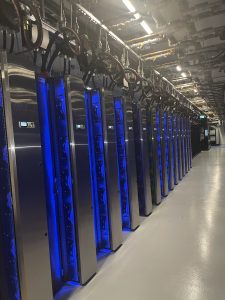There’s no single formula for building digital research infrastructure, but there is much to learn from our international peers. Case in point? Canada has a model of collaboration that reflects its unique character.
When building digital research infrastructure (DRI) in Canada, the scenario is much like the country: expansive, complex, and regionally diverse. Here, many partners, institutions and government bodies work together to build the assets the country needs to get a leg up in the global knowledge economy.
Against the backdrop of an evolving and dynamic space, the Digital Research Alliance of Canada (the Alliance) is unlocking the full potential of Canada’s commitment to leading-edge research. While other G7 countries, such as the United Kingdom, have made significant investments in DRI—spending twice as much as Canada—recent investments are helping Canada start to close the gap and catch up with its international peers.
With a strong vision and a federated approach, the Alliance and its partners are building a national strategy for DRI and gaining momentum in this high-tech race towards the future.
Here’s how the Alliance is building infrastructure to support data mobilisation, services to researchers, and bolstering a more skilled workforce through supercomputing, emerging quantum technologies, and artificial intelligence (AI) – to name a few of the key priorities in play.
Canada’s DRI model
The Alliance is a not-for-profit member-based organisation funded by the Government of Canada’s Ministry of Innovation, Science and Economic Development. In addition to generous support from the federal government, provinces and academic institutions contribute through matched investments that reflect the nation’s needs. The Alliance works to improve data access, build talent, and integrate services and security for Canada’s research community.
The Alliance operates on a five-year mandate with a set annual budget. This includes ongoing support for critical services to researchers and will be augmented by specific investments up to CAD $85m to reflect the emerging demands associated with AI.
“The DRI model we have, and are continuing to build, in Canada is something we’re very proud of,” said Alliance CEO, George Ross. “DRI is critical infrastructure, and we are better equipped to deliver on our commitments to researchers through a collaborative partnership approach. With the emergence of AI, quantum, and even more powerful supercomputers, we’re on the verge of an exciting digital transformation unlike anything we’ve seen before.”
Research for a better world
As the Alliance works to invest in digital research infrastructure, researchers here are also tapping into enhanced access for compute capacity, data management, and storage.
The result? They’re conducting studies that will change the face of climate change, healthcare, and much more. These academics from coast to coast are making progress on some of the world’s biggest challenges, such as:
Redefining cancer treatments with AI
At Simon Fraser University in Burnaby, British Columbia, engineering science professor Dr Mirza Faisal Beg is developing a novel AI-driven imaging platform to automate the extraction of human organ, tissue and tumour measurements from MRI, CT, and PET images faster, more accurately and more comprehensively than ever before. By harnessing AI, personalised treatment plans for individual cancer patients could soon be within reach.
Predicting permafrost thaw through data science
Dr Stephen Gruber, a professor of physical geography at Carleton University in Ottawa, Ontario, is an expert in mountain and polar environments. He’s working to predict ground ice loss with a permafrost data science platform.
As ground ice from permafrost (presently comprising 35-50% of Canadian land) melts, irreversible changes to the land and to infrastructure are afoot. In NSERC PermafrostNet and CREATE LEAP, Gruber and his team unite key scholars, relevant government agencies, industry, and Indigenous communities to create better information to adapt to permafrost thaw collectively.
Down the road, it could mean better health and prosperity for those living in the north.
Analysing genomic data of plants to improve food security
In Alberta, at the University of Calgary’s Yeaman Lab, Dr Sam Yeaman and their team are progressing in understanding how plants adapt to environmental change. The research first examines whether distantly related plant species- from sunflowers to poplars – rely on the same genes to adapt to ecological stress. With indications that key genes show signs of repeated evolution, developing stronger agricultural crops suited for a hotter and drier world may soon be possible.
Developing next-generation batteries
Dr Linda Nazar, a world-leading Tier I Canada Research Chair in Solid State Materials at Ontario’s University of Waterloo, is blazing new trails in sustainable battery research. Through supercomputing, she has developed materials that can help deliver energy at a high rate for solid-state electrochemical energy storage applications such as electric vehicles and drones. Her work is setting the stage for scaled-up, cleaner transportation solutions.
Better, faster, and greener high-performance computing and cloud storage are on the way
As researchers continue to make vital discoveries, Canada’s advanced research computing and digital cloud infrastructure is going through a renewal process.
The new systems coming on board at four national host sites will provide up to three times the performance and feature greater storage capacity and improved reliability. The latest generation of supercomputers will be more environmentally friendly by cooling more efficiently via water instead of air. Warm water expelled during the cooling process will also be re-purposed for secondary uses such as heating buildings.
The scope of the project reflects Canada’s collaborative model with DRI. The Alliance is providing the funding, strategic oversight, and support for the host site-led infrastructure transition process.
“We’re pleased to join forces with our partners across Canada to deliver world-class equipment to the academic community. Without this network of supercomputers, researchers would have to turn to commercial options that are far costlier,” Ross said.
Exploring new frontiers with quantum and AI
Canada is also securing its position as a leader in quantum research with a new collaboration between the Alliance, Quantum Algorithms Institute in Surrey, British Columbia, and Calcul Quebec in Montreal.
A new training initiative will prepare personnel at participating institutions to access and utilise quantum computing resources. While quantum computing is still in its infancy, its potential to transform how data is used and expedited is incredible, and exponentially faster than today’s supercomputers. The training goes far beyond preparing talent for the workforce; it’s also critical for enhancing the country’s data sovereignty and security.
Canada’s digital ecosystem is brimming with momentum. In December 2024, the Government of Canada launched a CA $2.4bn initiative for the Canadian Sovereign AI Compute Strategy. This massive investment signals the country’s ambitions to secure a Canadian advantage and set up future generations for success.
“Canada was the first country in the world to create a national AI strategy in 2017, and we’re not stopping now. Investments in AI and compute capacity in Canada will accelerate transformative scientific research, strengthen the national digital research infrastructure ecosystem and keep our economy moving forward. This is all about nation-building in the digital age, and we’re here for it,” Ross explained.
Spotlight on some key partners in Canada’s DRI space
Innovation, Science and Economic Development Canada (ISED)
ISED works to improve conditions for investment, enhance Canada’s innovation and increase Canada’s share of global trade to build a fair and efficient marketplace. ISED provides the operating funds for the Alliance mandate.
National AI institutes
Canada’s three national AI institutes – Amii in Edmonton, Mila in Montreal and Vector Insitute in Toronto are the central hubs of Canada’s thriving AI ecosystem. They spur national and international collaborations in the developing field of AI.
U15
U15 Canada is an association of fifteen leading research universities across Canada working to optimise research and innovation policies to develop highly qualified leaders across all sectors.
Cuccio
Cuccio is Canada’s community of information technology leaders. The 65 members collectively serve more than 95% of Canada’s university students.
Canadian Association of Research Libraries (CARL)
CARL represents Canada’s major academic libraries and works to build capacity and advocate for an environment that fosters and preserves access to scholarship and knowledge.
CANARIE
CANARIE connects Canada to the world. Their programmes equip the country’s researchers and students to excel globally through a high-speed network connecting researchers to global data, technology and colleagues.
Canada Foundation for Innovation (CFI)
CFI is a non-profit corporation that invests in research infrastructure at Canada’s universities, colleges, research hospitals and non-profit research institutions.
National Research Council (NRC)
The NRC partners with Canadian industry to take research impacts from the lab to the marketplace for maximum benefit.










